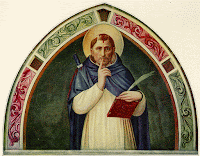
Hard by the Holy Well, there is a major relic of St. Vincent of Saragossa in the Anglican Shrine of Our Lady of Walsingham. This was always a cause for joy for me to see a ferretory bearing a relic of my patron saint so close to the Holy Well and the Holy House in the Anglican shrine at Walsingham.
Now some men named 'Vincent' are given the name because of other saints such as St. Vincent de Paul or St. Vincent Ferrer, but the very first saint in the Catholic Church named Vincent was the first Holy Martyr of Spain. From Wikipedia we gather the following about the great preaching saint:
St. Vincent, the protomartyr of Spain, is variously called Saint Vincent of Saragossa, Vincent of Huesca, Vincent the Deacon, or St. Vincent Martyr. He is the patron saint of Lisbon. His feast day is January 22 in the Roman Catholic Church, and November 11 in the Eastern Orthodox Churches. He was born at Huesca and martyred under the Emperor Diocletian around the year 304.
Vincent served as the deacon of Valerius of Saragossa, the city's bishop. Imprisoned in Valencia for his faith, and tortured on a gridiron, Vincent, like many early martyrs in the early hagiographic literature, succeeded in converting his jailer. Though he was finally offered release if he would consign Scripture to the fire, Vincent refused.
The earliest account of Vincent's martyrdom is in a carmen (lyric poem) written by the poet Prudentius, who wrote a series of lyric poems, Peristephanon ("Crowns of Martyrdom"), on Hispanic and Roman martyrs. Prudentius describes how Vincent was brought to trial along with his bishop Valerius, and that since Valerius had a speech impediment, Vincent spoke for both, but that his outspoken fearless manner so angered the governor that Vincent was tortured and martyred, though his aged bishop was only exiled.
According to legend, after being martyted, ravens protected St. Vincent's body from being devoured by wild animals, until his followers could recover the body. His body was taken to what is now known as Cape St. Vincent; a shrine was erected over his grave, which continued to be guarded by flocks of ravens. King Alfonso Henriques (1139-1185) had the body of the Saint exhumed in 1173 and brought it by ship to the Monastery of São Vicente de Fora in Lisbon. This transfer of the relics is depicted on the coat of arms of Lisbon.
Three elaborated hagiographies, all based ultimately on a lost 5th century Passion, circulated in the Middle Ages.
Though Vincent's tomb in Valencia became the earliest center of his cult, he was also honoured at his birthplace and his reputation spread from Saragossa. The city of Oviedo in Asturias grew about the church dedicated to Vincent.
Beyond the Pyrenees, he was venerated first in the vicinity of Béziers, and at Narbonne. Castres became an important stop on the international pilgrimage routes to Santiago de Compostela when the relics of Vincent were transferred to its new abbey-church dedicated to Saint Benedict from Saragossa in 863, under the patronage of Salomon, count of Cerdanya.
When the Catholic bishops of Visigothic Iberia succeeded in converting King Reccared and his nobles to Trinitarian Christianity they built the cathedral of Córdoba in honour of Vincent. When the Moors came, in 711, the church was razed and its materials incorporated in the Mezquita, the "Great Mosque" of Cordoba.
Vincent is also the patron of vintners and vinegar-makers.

And finally, as Saint Vincent is my patron saint that makes today my Saint's Name Day! May we by grace share in the perseverance of St. Vincent and so never tire to bear witness to Christ the Eternal Word. So let us all remember the good Saint Vincent -- the first in Spain to lay down his life for the sake of the Lord of Life, our Saviour Jesus Christ -- and ask him to pray for us and to intercede for the entire Diaconate in Christ. Amen.
Good St. Vincent Martyr,
pray for us
who are named for thee.
Amen.
+Laus Deo.















